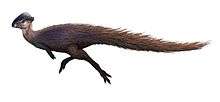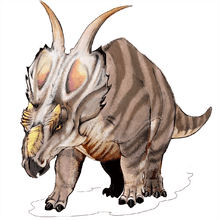Texacephale
| Texacephale Temporal range: Late Campanian, 77 Ma | |
|---|---|
| Scientific classification | |
| Kingdom: | Animalia |
| Phylum: | Chordata |
| Class: | Reptilia |
| Clade: | Dinosauria |
| Order: | †Ornithischia |
| Family: | †Pachycephalosauridae |
| Genus: | †Texacephale Longrich, Sankey & Tanke, 2010 |
| Species: | †T. langstoni |
| Binomial name | |
| Texacephale langstoni Longrich et al., 2010 | |
Texacephale is a genus of basal pachycephalosaurid dinosaur from the Campanian stage of the Late Cretaceous. The type species is Texacephale langstoni; its fossils were discovered in the Aguja Formation and described in 2010 by Longrich, Sankey and Tanke. The generic name means Texas + "head" (kephale in Greek) in reference to its place of discovery, and the specific name honors Wann Langston.[1]
Discovery
The holotype specimen of Texacephale, LSUMNS 20010, is composed of fused frontals and parietals. A second specimen, LSUMNS 20012, is composed of an incomplete frontoparietal dome.[1] According to the team, the fossilized dome of the animal possessed five to six vertical flanges on each lateral side, connecting it with the postorbital bone. The team interpreted these structures as interlocking "gears" that would help deal with stress on the bone during head-butting,[2] a hypothetical behavior that had earlier been challenged by other authors.[3][4]
Phylogeny
Cladogram after Longrich, Sankey and Tanke (2010).[1]
| Pachycephalosauridae |
| ||||||||||||||||||||||||||||||||||||||||||||||||||||||||||||||||||||||||||||||||||||
| |
See also
References
- 1 2 3 Longrich, N.R., Sankey, J., and Tanke, D. (2010). "Texacephale langstoni, a new genus of pachycephalosaurid (Dinosauria: Ornithischia) from the upper Campanian Aguja Formation, southern Texas, USA". Cretaceous Research. 31 (2): 274–284. doi:10.1016/j.cretres.2009.12.002.
- ↑ Head-ramming dino had ‘gears’ in skull
- ↑ Dinosaur Study Makes No Butts About It / Round-skull species didn't bash heads
- ↑ Cranial histology of pachycephalosaurs (Ornithischia: Marginocephalia) reveals transitory structures inconsistent with head-butting behavior


